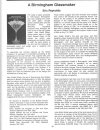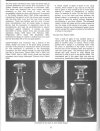Pedrocut
Master Barmmie
John Walsh Walsh ( -1864)
John Walsh Walsh has been, as far as I can tell, only been mentioned a couple of times on the Forum. Once in connection with the Glass Industry, and the other on a thread with his name, but little detail. Seeking information about the chap I looked in a book written by E Edwards in 1877, and I think JW Walsh deserves his mention with the famous! Below is an abridged version of what the book tells us...
The towering figure of John Walsh Walsh, with massive head and fringe of wavy hair, was born in Mansfield and named in the peculiar way as one of the Baptism sponsors, when asked what to name the boy said "John Walsh," and so the infant became John Walsh Walsh.... He would say that the name was worth hundreds a year to him in Business. "Anybody can be John Walsh, but John Walsh Walsh, once heard was never forgotten."
He first worked for Pickford and Co. Then, seeing that the use of aerated beverages could become general, he left and started the manufacture of soda water. In partnership with Mr Nelson, at Leamington, he started manufacture, by patent process, of artificial isinglass and gelatine. Besides these, he had a mustard mill, was an extensive dealer in cigars, and was for many years with Mr Jeffries in the manufacture of marine glue. In 1851 he took over a glass manufactory in Hill Street, which he converted into a great success. The growing business was removed to the extensive works at Lodge Road.
For some years he was a member of the Birmingham Town Council, and must be remembered for his work to induce the Council to buy Aston Park for the town when its price was low. But his name will probably longer held in rememberence in connections with the colossal fetes at Aston Park in 1856; he was the originator, and to the success of which he devoted himself...The idea had been hatched at the Woodman Inn in Easy Row, during discussions about Aston Park and also the financial situation of the Queen's Hospital. "Why not borrow the Park and give a pic-nic for the hospital?"
It was no pic-nic, it was such a fete as Birmingham had never witnessed, and would not readily forget! The fete was held on the 28 July, and as the day approached it was evident from the sale of tickets that the attendance would far exceed expectations, and another 25,000 tickets were ordered.
"As noon approached train after train deposited at Aston Station hundreds and thousands of gaily-attired Black Country people. Special trains ran from New Street as fast as they could be got to order; all the approaches to the park were crammed with serried lines, three or four abreast, omnibus, carriages, carts, cabs, and every other imaginable vehicle; whilst thousands upon thousands of dusty pedestrians jostled each other in the crowded roads...until at length the number of persons within the grounds exceeded the enormous total of fifty thousands!"
Platforms for dancing, and pavilions for musicians...beyond in the valley a long range of poles and skeleton forms showed where the fireworks were in preparation. Down in the corner stood a large stack of firewood through which, the "Fire-King" was to pass uninjured. Swings, merry-go-rounds...
...suddenly a sound like that of roaring waves deepened and increased in volume...it was the noise of laughter simultaneously from fifty thousand people..from a mysterious looking shed John Inshaw launched a balloon shaped like a pig! Piggy rose majestically over the vast sea of upturned faces...but at length (Piggy) apparently disgusted at being so much laughed at, started off in the direction of Coleshill, and, to the intense amusement of everybody, persited in travellling tail foremost...
...Then came the fireworks! No such display had ever before been seen in the Midland Counties. The flights of the rockets, the marvellously-ingenious set pieces, and the wonderful blue lights, gave intense delight....but the climax was reached when, as a finale, the words SAVE ASTON HALL came out in glowing fire...And, amid the congratulations of everybody, the first of the Aston fetes came to an end.
[More was to come, in September the crowd was 90,000 and the Hospital received another £1,770.
I believe that the firm John Walsh Walsh at Lodge Road continued trading until about 1951?]
John Walsh Walsh has been, as far as I can tell, only been mentioned a couple of times on the Forum. Once in connection with the Glass Industry, and the other on a thread with his name, but little detail. Seeking information about the chap I looked in a book written by E Edwards in 1877, and I think JW Walsh deserves his mention with the famous! Below is an abridged version of what the book tells us...
The towering figure of John Walsh Walsh, with massive head and fringe of wavy hair, was born in Mansfield and named in the peculiar way as one of the Baptism sponsors, when asked what to name the boy said "John Walsh," and so the infant became John Walsh Walsh.... He would say that the name was worth hundreds a year to him in Business. "Anybody can be John Walsh, but John Walsh Walsh, once heard was never forgotten."
He first worked for Pickford and Co. Then, seeing that the use of aerated beverages could become general, he left and started the manufacture of soda water. In partnership with Mr Nelson, at Leamington, he started manufacture, by patent process, of artificial isinglass and gelatine. Besides these, he had a mustard mill, was an extensive dealer in cigars, and was for many years with Mr Jeffries in the manufacture of marine glue. In 1851 he took over a glass manufactory in Hill Street, which he converted into a great success. The growing business was removed to the extensive works at Lodge Road.
For some years he was a member of the Birmingham Town Council, and must be remembered for his work to induce the Council to buy Aston Park for the town when its price was low. But his name will probably longer held in rememberence in connections with the colossal fetes at Aston Park in 1856; he was the originator, and to the success of which he devoted himself...The idea had been hatched at the Woodman Inn in Easy Row, during discussions about Aston Park and also the financial situation of the Queen's Hospital. "Why not borrow the Park and give a pic-nic for the hospital?"
It was no pic-nic, it was such a fete as Birmingham had never witnessed, and would not readily forget! The fete was held on the 28 July, and as the day approached it was evident from the sale of tickets that the attendance would far exceed expectations, and another 25,000 tickets were ordered.
"As noon approached train after train deposited at Aston Station hundreds and thousands of gaily-attired Black Country people. Special trains ran from New Street as fast as they could be got to order; all the approaches to the park were crammed with serried lines, three or four abreast, omnibus, carriages, carts, cabs, and every other imaginable vehicle; whilst thousands upon thousands of dusty pedestrians jostled each other in the crowded roads...until at length the number of persons within the grounds exceeded the enormous total of fifty thousands!"
Platforms for dancing, and pavilions for musicians...beyond in the valley a long range of poles and skeleton forms showed where the fireworks were in preparation. Down in the corner stood a large stack of firewood through which, the "Fire-King" was to pass uninjured. Swings, merry-go-rounds...
...suddenly a sound like that of roaring waves deepened and increased in volume...it was the noise of laughter simultaneously from fifty thousand people..from a mysterious looking shed John Inshaw launched a balloon shaped like a pig! Piggy rose majestically over the vast sea of upturned faces...but at length (Piggy) apparently disgusted at being so much laughed at, started off in the direction of Coleshill, and, to the intense amusement of everybody, persited in travellling tail foremost...
...Then came the fireworks! No such display had ever before been seen in the Midland Counties. The flights of the rockets, the marvellously-ingenious set pieces, and the wonderful blue lights, gave intense delight....but the climax was reached when, as a finale, the words SAVE ASTON HALL came out in glowing fire...And, amid the congratulations of everybody, the first of the Aston fetes came to an end.
[More was to come, in September the crowd was 90,000 and the Hospital received another £1,770.
I believe that the firm John Walsh Walsh at Lodge Road continued trading until about 1951?]









